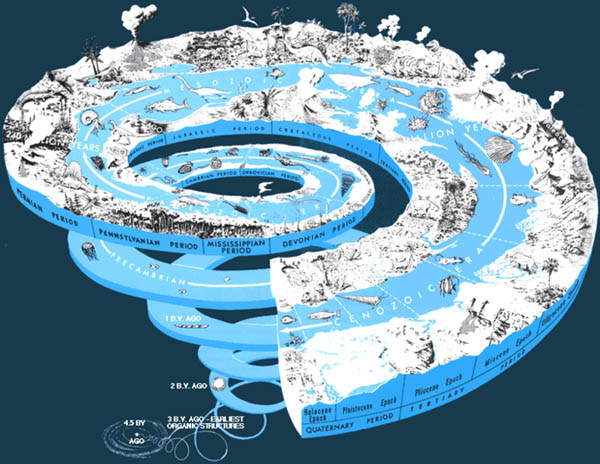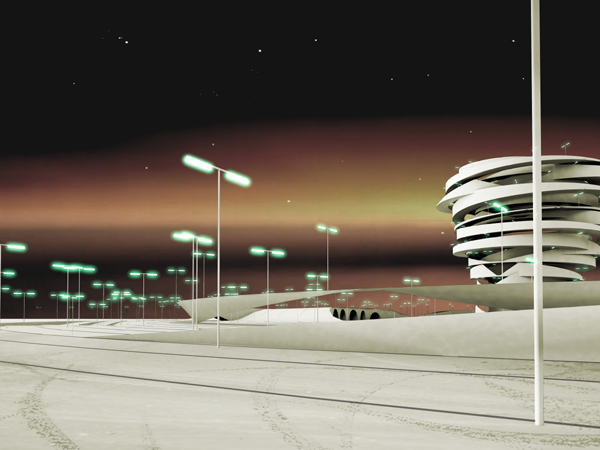Precambrian Motorways
 [Image: The geological time scale, in spiral form; via the USGS].
[Image: The geological time scale, in spiral form; via the USGS].Upon seeing the above diagram, it occurred to me that you could – or should – redesign the 10 Mile Spiral so that it communicates geological information.
In other words, you could literally be driving up a diagram of the Earth's deep history.
Vacationing families tootle their way around the spiral, eating ice cream cones – twisting in loops, upward through space – reading signs posted on either side about Precambrian tectonics...
 [Image: The 10 Mile Spiral, by Terraswarm].
[Image: The 10 Mile Spiral, by Terraswarm].At the very least, it would make the US highway system a bit more educationally worthwhile...
Every off-ramp of I-95, for instance, would tell you a quick story: the discovery of edicarans, as you pull off to get gas; the rotational history of the North Pacific Gyre, explained to you at a Georgia rest-stop; outside New York City you read in awe, slowing down at a toll-booth, about the ancient reversal of the Amazon River...
Signs like these proliferate, inspiring a whole new generation to take endless car trips: driving up and down the east coast of the United States, reading about geology.
Soon, though, all those curious kids and their millions of cars emit so much carbon dioxide the Atlantic weather system shifts, plunging them all into an ice age... a planetary event that will someday be described on a sign and posted next to a highway in Kentucky.
(Geo-spiral found via Leah Beeferman).





Comments are moderated.
If it's not spam, it will appear here shortly!
Of course, a pretty funny alternative to this would be to reverse it: in other words, you go to sites of geological interest - in Utah, Arizona, Washington state, northern Wisconsin, etc. - and you install educational signs about the US highway system.
You and your wife one summer hike down to the bottom of the Grand Canyon, where you head off to look for water... stumbling, instead, upon a sign about San Francisco's Bay Bridge.
There's something like this at the Hayden Planetarium in the American Museum of Natural History in New York. From the website:
Harriet and Robert Heilbrunn Cosmic Pathway
Following the explosive nuclear fusion of the Big Bang, visitors exit onto the Harriet and Robert Heilbrunn Cosmic Pathway, a dramatic, spiraling ramp that ushers them through 13 billion years of cosmic evolution. At the start of the walkway, children and adults alike can measure the length of their stride and determine how many millions of years pass with each step. Thirteen markers along the way denote the passage of each billion years, and at eight landings, computer interactives are available to help visitors visualize how large the universe was at that point in time. To illustrate the development of the universe, 220 astronomical images are on view with the cosmic "redshift," a measurement that indicates the age of the light and the distance of the astronomical objects shown. Artifacts are also on display, including presolar grains extracted from a meteorite, and the fossilized tooth of a giant carnivorous dinosaur. At the end of the 360-foot circular pathway, the thickness of a human hair illustrates the relative duration of human history, from cave paintings to the present.
The Wildlife Through the Ages: Flaming Gorge-Uintas National Scenic Byway does just that. The geology of the region is tilted on its side, so the layers stick out of the ground at an almost vertical angle. Driving along the roads that wind around through these formations you see signs every now and then naming the layers, with just enough information to be legible from a moving car.
Brilliant! Perhaps this is something Geico can finance?
Post a Comment